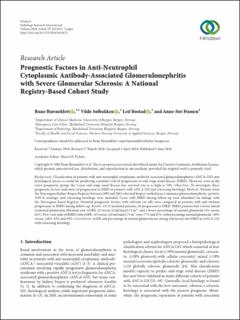Prognostic factors in anti-neutrophil cytoplasmic antibody-associated glomerulonephritis with severe glomerular sclerosis: a national registry-based cohort study
Peer reviewed, Journal article
Published version

Åpne
Permanent lenke
https://hdl.handle.net/1956/19255Utgivelsesdato
2018-06-03Metadata
Vis full innførselSamlinger
Originalversjon
https://doi.org/10.1155/2018/5653612Sammendrag
Background. Classification of patients with anti-neutrophil cytoplasmic antibody-associated glomerulonephritis (ANCA-GN) into histological classes is useful for predicting a patient’s risk of progression to end-stage renal disease (ESRD). However, even in the worst prognostic group, the 5-year end-stage renal disease-free survival rate is as high as 50%. Objectives. To investigate those prognostic factors indicative of progression to ESRD in patients with ANCA-GN and sclerosing histology. Methods. Patients from the Norwegian Kidney Biopsy Registry between 1991 and 2012 who had biopsy verified pauci-immune glomerulonephritis, positive ANCA serology, and sclerosing histology were included. Cases with ESRD during follow-up were identified via linkage with the Norwegian Renal Registry. Potential prognostic factors with relevant cut-offs were compared in patients with and without progression to ESRD during follow-up. Results. Of 23 included patients, 10 progressed to ESRD. ESRD patients had a lower initial estimated glomerular filtration rate (eGFR; 21 versus 52 ml/min/1.73 m2) and a lower percentage of normal glomeruli (4% versus 15%). Five-year risks of ESRD with eGFR >15 versus ≤15 ml/min/1.73 m2 were 77% and 15%, with percentage normal glomeruli >10% versus ≤10%, 83% and 39%. Conclusions. eGFR and percentage of normal glomeruli are strong risk factors for ESRD in ANCA-GN with sclerosing histology.
